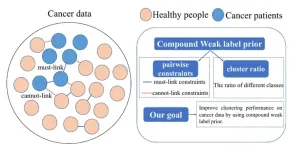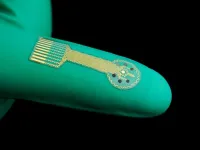(Press-News.org) An international research team has discovered a new way to effectively treat cancer, by using nutrients to reactivate suppressed metabolic pathways in cancer cells.
The researchers used a common amino acid, tyrosine, packaged as a nanomedicine, to change the metabolism of melanoma, a deadly skin cancer, and prevent cancer growth.
Australia has the highest rate of skin cancer in the world. This new approach could be combined with current therapies to better treat melanoma. The technique also has the potential to treat other types of cancer.
The study, Nutrient-delivery and metabolism reactivation therapy for melanoma, was led by Professor Wenbo Bu from Fudan University and Professor Dayong Jin from the University of Technology Sydney, and recently published in the prestigious journal Nature Nanotechnology.
Tyrosine has limited bioavailability in living organisms. However, the researchers used a new nanotechnology technique to package it into tiny particles called nanomicelles, which are attracted to cancer cell membranes, and break down easily, boosting absorption.
The research team then tested the innovative treatment in mice and in human-derived melanoma cells in the lab and found that the tyrosine nanomicelles reactivated dormant metabolic pathways, triggered melanin synthesis, and inhibited tumour growth.
“Uncontrolled rapid growth is a key feature that distinguishes cancer cells from normal cells. In cancer cells some metabolic pathways are over-activated, and others are suppressed, to create the environment necessary for rapid spread,” said Professor Jin.
“While a few metabolism-based drugs for cancer have been developed previously, such as aromatase inhibitors impeding estrogen synthesis in breast cancer and HK2 inhibitors targeting glycolysis in various cancers, these work by suppressing over-activate metabolic pathways,” he said.
“Our research shows for the first time that cancer can be stopped by reactivating metabolic pathways that are dormant. And this can be done using simple nutrients, such as amino acids, sugars, and vitamins, which are safe, readily available and well tolerated,” said Professor Bu.
Different types of cancer will respond to different nutrients. Melanoma cells develop from melanocytes – skin cells that produce melanin. Tyrosine is needed to produce melanin and it can stimulate melanin production, hence its effectiveness with melanoma.
The reactivation of melanin synthesis forces the melanoma cell to reduce glycolysis, the process of converting sugar to energy, which is believed to be the mechanism for its anti-cancer effect.
Melanoma cells are also susceptible to heat stress. The researchers found that by combining tyrosine nanomicelle treatment with near-infrared laser treatment, they were able to eradicate melanoma in mice after six days and it did not reoccur during the study period.
The findings suggest a promising a new frontier in the use of nanomedicine for cancer therapy.
END
How targeted nutrients can fight cancer
Reactivating suppressed metabolic pathways in cancer cells can help fight cancer.
2024-06-18
ELSE PRESS RELEASES FROM THIS DATE:
Constrained clustering with weak label prior
2024-06-18
Clustering is widely exploited in data mining. It has been proved that embedding weak label prior into clustering is effective to promote its performance. Previous researches mainly focus on only one type of prior. However, in many real scenarios, two kinds of weak label prior information, e.g., pairwise constraints and cluster ratio, are easily obtained or already available. How to incorporate them to improve clustering performance is important but rarely studied.
To deal with this problem, a research team led by Chenping ...
New “smart bandages” hold potential for revolutionizing the treatment of chronic wounds
2024-06-18
Chronic wounds, which include diabetic ulcers, surgical wounds, pressure injuries, and other problems, are deadlier than many people realize. Patients with chronic wounds have a five-year survival rate around 70%, worse than that of breast cancer, prostate cancer and other serious diseases. Treating wounds is also expensive, costing an estimated $28 billion each year in the U.S. alone.
A team of researchers from the Keck School of Medicine of USC and the California Institute of Technology (Caltech) is developing a series of cutting-edge technologies to revolutionize wound care, including smart bandages that would automatically sense and ...
Rapid test of cerebrospinal fluid decreases time to diagnosis for brain tumors
2024-06-18
A test that looks for genetic hallmarks of brain cancers in samples of cerebrospinal fluid can decrease the time to diagnosis and eliminate the need for invasive brain biopsies for some patients. Mass General Brigham experts in neurosurgery, cancer and pathology worked together to develop a rapid, genotyping test that can detect key mutations associated with brain cancers from samples taken during a lumbar puncture. The team evaluated the technique known as TetRS (Targeted Rapid Sequencing) among 70 patients admitted to Massachusetts General Hospital with new central nervous system ...
Cyberbullying and sexual harassment rampant in esports
2024-06-18
It’s one of the fastest growing industries globally, raking in millions for the best players and attracting a huge fanbase, but a new Australian study has revealed the dark side of professional video gaming: cyberbullying and sexual harassment.
Even though the esports industry is a diverse community, cyberbullying is rampant in this virtual world, and cis-gendered and trans-gendered women players are disproportionately more likely to be sexually harassed than men.
Despite women making up 46% of the world’s three billion video gamer players, according to a new paper published in Entertainment Computing, women who play professionally (16% of esports competitors ...
New study shows mechanisms of Hagfish burrowing into deep sea sediment
2024-06-18
Scientists at the Schmid College of Science and Technology at Chapman University developed a novel way to observe the elusive burrowing behavior of hagfish. Dr. Douglas S Fudge and his team created a specialized tank of transparent gelatin in order to visualize how the hagfish behave and locomote within sediments.
Hagfishes are bottom-dwelling marine animals that are capable of producing startling amounts of defensive slime when they are provoked. Understanding the burrowing activities of hagfishes could lead to increased knowledge of sediment turnover in marine benthic habitats, new insights into the reproductive behavior of hagfishes or ...
Study suggests at-camera gaze can increase scores in simulated interviews
2024-06-18
Eye-contact has a significant impact on interpersonal evaluation, and online job interviews are no exception. In addition to the quality of a resume, the direction of the interviewee’s gaze might help (or hinder) their chances of securing the job.
Researchers published their results in Scientific Reports on May 31.
The study simulated online job interviews. Twelve students who participated in the study as a role of interviewees presented themselves twice, once looking directly at a web camera, and the other looking towards the screen. ...
NYU Tandon researchers selected for National Artificial Intelligence Research Resource Pilot to enhance AI vision models
2024-06-17
An NYU Tandon School of Engineering project led by Chinmay Hegde – Associate Professor in the Department of Computer Science and Engineering and the Department of Electrical and Computer Engineering – is one of the first 35 initiatives selected for the National Artificial Intelligence Research Resource (NAIRR) Pilot by the U.S. National Science Foundation (NSF) and Department of Energy, a result of President Biden's Executive Order on the Safe, Secure and Trustworthy Development and Use of AI.
The NAIRR Pilot aims to connect U.S. researchers and educators with the computational power, data resources, ...
Investigating the origins of the crab nebula with NASA's Webb
2024-06-17
A team of scientists used NASA’s James Webb Space Telescope to parse the composition of the Crab Nebula, a supernova remnant located 6,500 light-years away in the constellation Taurus. With the telescope’s MIRI (Mid-Infrared Instrument) and NIRCam (Near-Infrared Camera), the team gathered data that is helping to clarify the Crab Nebula’s history.
The Crab Nebula is the result of a core-collapse supernova from the death of a massive star. The supernova explosion itself was seen on Earth in 1054 CE and was bright enough to view during the daytime. The much fainter remnant observed today ...
The KIT ligand KITLG promotes portal vein tumor thrombosis by up-regulating COL4A1 through STAT3-SMAD2 signaling in hepatocellular carcinoma
2024-06-17
https://www.scienceopen.com/hosted-document?doi=10.15212/AMM-2023-0049
Announcing a new publication for Acta Materia Medica journal. Portal vein tumor thrombosis (PVTT), a severe complication of hepatocellular carcinoma (HCC), markedly influences patient prognosis by fostering a hypercoagulable state. However, its molecular underpinnings remain largely unexplored. This study sheds light on the critical role of the KIT ligand (KITLG) in modulating expression of the collagen gene COL4A1 via the STAT3-SMAD2 signaling pathway, thereby influencing platelet activation and PVTT development. Extensive analysis of PVTT tissue samples, ...
Recent Georgia Tech grad earns ACM Doctoral Dissertation Award for creating devices that look like stickers and can harvest energy from the environment
2024-06-17
ACM, the Association for Computing Machinery, today announced that Nivedita Arora, of Northwestern University is the recipient of the ACM Doctoral Dissertation Award for her dissertation “Sustainable Interactive Wireless Stickers: From Materials to Devices to Applications,” which demonstrated wireless and batteryless sensor nodes using novel materials and radio backscatter.
Arora’s research envisions creating sustainable computational materials that operate by harvesting energy from the environment and, at the end ...
LAST 30 PRESS RELEASES:
Ants: An untapped resource in the development of antibiotics?
Archaeologists use AI to create prehistoric video game
Mitochondria migrate toward the cell membrane in response to high glucose levels
Tiny viral switch offers hope against drug-resistant bacteria
Most parents aware of early peanut introduction guidelines, but confused about details
HPV vaccine can protect against severe lesions of the vulva and vagina
Virtual care provision and emergency department use among children and youth
Quadrivalent HPV vaccine and high-grade vulvovaginal lesions
Insights into dry eyes gained from stem cell-derived tear glands
Researchers identify 166 human pluripotent stem cell lines available for use in clinical applications
Europa Clipper instrument uniquely observed interstellar comet 3I/ATLAS
UN University Report challenges climate change as sole trigger of Syrian Civil War, exposing governance failures in drought response
Real estate investment trust (REIT) acquisition associated with hospital closure and bankruptcy
New Raman imaging system detects subtle tumor signals
Boston Children’s receives a $7.5 million grant from Aligning Research to Impact Autism (ARIA) to provide clinical research coordination for the IMPACT Network
Spray-on antibacterial coating offers new protection for plants against disease and drought
ESMT Berlin study: What makes a first offer successful in negotiations
Groundbreaking ceremony marks the beginning of CTAO-South Array construction in Chile
Why swearing makes you stronger
What prevents more cancer patients from enrolling in potentially life-saving clinical trials?
UK’s worst-case climate risks laid bare for lawmakers
A decline in churchgoing linked to more deaths of despair
TAMEST announces Maralice Conacci-Sorrell, Ph.D., UT Southwestern Medical Center, as 2026 Mary Beth Maddox Award & Lectureship Recipient
Global study to evaluate whether dengue outbreaks can be anticipated earlier
Chonnam National University researchers propose innovative voltage-loop control for power factor correction
Accelerating next-generation drug discovery with click-based construction of PROTACs
Detecting the hidden magnetism of altermagnets
$7M gift supports health research, engineering and athletics at UT San Antonio
NU-9 halts Alzheimer’s disease in animal model before symptoms begin
Hospitals acquired by real estate investment trusts associated with greater risk of bankruptcy, closure
[Press-News.org] How targeted nutrients can fight cancerReactivating suppressed metabolic pathways in cancer cells can help fight cancer.




